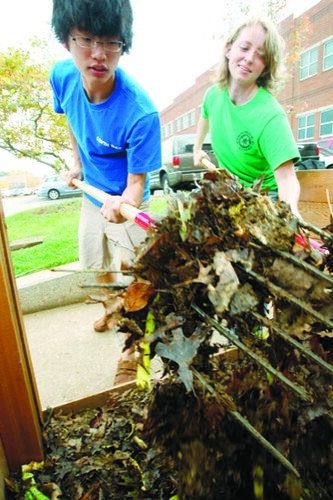
SPEAR volunteers turn last year’s leaves into next year’s compost. Photo by John Russell
Vanderbilt has more trees than undergraduate students–an estimated 7,500 leaf- producing specimens on its 330-acre campus. Until recently, all the leaves collected from autumns past were stockpiled at Natchez Triangle because nobody could figure out what to do with them.
“The Grounds Department wanted to incorporate green principles to compost the leaves for our own use on the grounds,” says Judson Newbern, associate vice chancellor for campus planning and construction. “But we had been unsuccessful at transforming the massive pile of leaves into usable compost.”
Working with Students Promoting Environmental Awareness and Recycling (SPEAR), Vanderbilt hired Marcus Kerske, who with his family operates Nashville’s Gardens of Babylon, a nursery and landscaping center based on sustainable practices.
“Our biggest challenge was getting enough oxygen into the leaves to allow the right decomposition,” says Kerske. An enormous single pile of leaves was reconfigured into a 90-foot row about 7 feet high, so that a front-end loader could turn it to expose all layers to oxygen.
The first batch of rich, dark compost was loaded into trucks recently and returned across campus to be spread under the trees that shed those leaves several seasons ago.
“Compost helps rejuvenate plants and trees in urban settings due to the richness of the microorganisms in it,” explains Kerske. “This is the first step toward rebuilding the soil structure in these beds.” The insulating layer of compost will also be helpful if last summer’s drought conditions recur.
“The bigger concept each autumn will be to shred some leaves finely enough to fertilize our lawns without shading out the grass, to shred some onto bed areas under trees, and to haul enough leaves to the Natchez Trace composting operation to keep the cycle going in order to renew the vigor of our campus soil for future generations,” says Newbern.